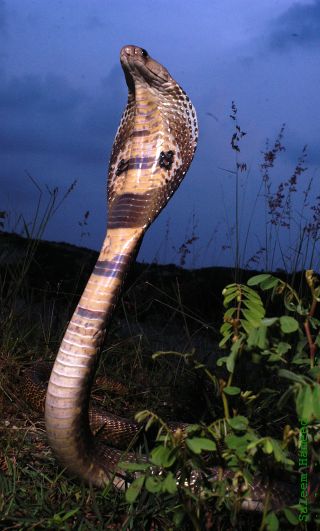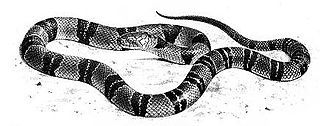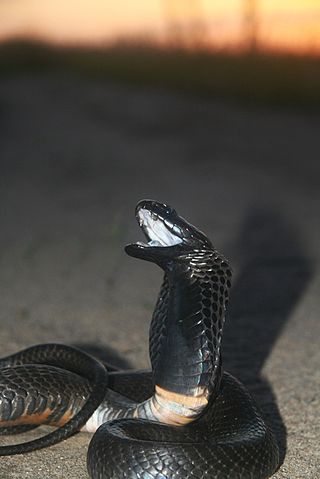
The Indian cobra, also known as the spectacled cobra, Asian cobra, or binocellate cobra, is a species of cobra found in India, Pakistan, Bangladesh, Sri Lanka, Nepal, and Bhutan, and a member of the "big four" species that are responsible for the most snakebite cases in India.

The Cape cobra, also called the yellow cobra, is a moderate-sized, highly venomous species of cobra inhabiting a wide variety of biomes across southern Africa including arid savanna, fynbos, bushveld, desert and semi-desert regions.

Naja is a genus of venomous elapid snakes commonly known as cobras. Members of the genus Naja are the most widespread and the most widely recognized as "true" cobras. Various species occur in regions throughout Africa, Southwest Asia, South Asia, and Southeast Asia. Several other elapid species are also called "cobras", such as the king cobra and the rinkhals, but neither are true cobras, in that they do not belong to the genus Naja, but instead each belong to monotypic genera Hemachatus and Ophiophagus.

Boulengerina is a genus or subgenus of elapid venomous snakes known commonly as water cobras, so named because of their semiaquatic nature. The genus has two recognised species, which are native to central and southern Africa.

The many-banded snake, also known as the burrowing cobra is a species of venomous elapid snake. The species is found in the Republic of Congo, the Democratic Republic of Congo and Cameroon in Africa.

The Chinese cobra, also called the Taiwan cobra, is a species of cobra in the family Elapidae, found mostly in southern China and a couple of neighboring nations and islands. It is one of the most prevalent venomous snakes in China and Taiwan, which has caused many snakebite incidents to humans.

The red spitting cobra is a species of spitting cobra native to Africa.

The Egyptian cobra, also known as Ouraeus(derived from the Ancient Greek word: οὐραῖος - Greek pronunciation: [οὐραῖος]), is one of the most venomous snakes in North Africa, which has caused many snakebite incidents to humans. It averages roughly 1.4 metres (4.6 ft), with the longest recorded specimen measuring 2.59 metres (8.5 ft).

The Indochinese spitting cobra also called the Thai spitting cobra, black and white spitting cobra, Siamese spitting cobra, is a species of spitting cobra found in Southeast Asia.

The black-necked spitting cobra is a species of spitting cobra found mostly in sub-Saharan Africa. They are moderately sized snakes that can grow to a length of 1.2 to 2.2 m in length. Their coloration and markings can vary considerably. They prey primarily on small rodents. They possess medically significant venom, although the mortality rate for untreated bites on humans is relatively low. Like other spitting cobras, they can eject venom from their fangs when threatened. The neurotoxic venom irritates the skin, causing blisters and inflammation, and can cause permanent blindness if the venom makes contact with the eyes and is not washed off.

The snouted cobra, also called the banded Egyptian cobra, is a highly venomous species of cobra found in Southern Africa.

The forest cobra, also commonly called the black cobra and the black and white-lipped cobra, is a species of venomous snake in the family Elapidae. The species is native to Africa, mostly the central and western parts of the continent. It is the largest true cobra species with a record length of 3.2 metres.
The Senegalese cobra is a species of cobra in the genus Naja that is found in West Africa.

Naja nigricincta is a species of spitting cobra in the genus Naja, belonging to the family Elapidae. The species is native to the deserts and drier regions of southern Africa. The species is largely nocturnal, and is often found while crossing roads at night. There are two recognized subspecies.

Naja christyi, commonly known as the Congo water cobra or Christy's water cobra, is a species of venomous snakes belonging to the family Elapidae. The species is native to Sub-Saharan Africa.

Anchieta's cobra, sometimes referred to as the Angolan cobra, is a species of venomous snake in the family Elapidae. The species is native to Southern Africa.

The Nubian spitting cobra or Egyptian spitting cobra is a species of spitting cobra native to Africa.
The black forest cobra is a species of cobra in the genus Naja that is found in West Africa.

The West African banded cobra is a species of cobra in the genus Naja that is found in West Africa.

The dwarf water cobra is a small, venomous species of cobra found in the Democratic Republic of Congo (Katanga). The dwarf water cobra is part of the subgenus Boulengerina, which includes related species such as Naja annulata, Naja christyi, and Naja melanoleuca.




















